Physical Address
304 North Cardinal St.
Dorchester Center, MA 02124
If an abdominal aortic aneurysm progresses to rupture, survival is very unlikely. If discovered before rupture, survival is highly likely.
Most aneurysms are fusiform, which makes them readily diagnosable with ultrasound. Clinicians must also be aware of related entities that are more difficult to diagnose with ultrasound, including eccentric aneurysms, pseudoaneurysms, and penetrating ulcers.
Ultrasound is not an appropriate method for the diagnosis of vascular emergencies in the abdomen. Particularly, it is not appropriate in the settings of possible ruptured abdominal aortic aneurysm and of acute mesenteric ischemia.
In less acute situations, ultrasound has a strong role in the diagnosis of aortic aneurysm, renal artery stenosis, and chronic mesenteric ischemia. It also has a role in surveillance of aneurysms to assess growth and in treated aneurysms to assess for endoleaks.
Ultrasound also has a role in the diagnosis of abdominal venous abnormalities. Clinicians should particularly be aware of the diagnoses of nutcracker syndrome and pelvic congestion syndrome, conditions that are probably underdiagnosed.
Atherosclerosis causes more deaths than any other disease in the Western world. It is the main cause of cardiovascular diseases, including heart disease, cerebrovascular accident (stroke), hypertension, and peripheral vascular disease. It is a primary contributor to several other conditions, such as heart failure, arrhythmias (including atrial fibrillation), and cardiomyopathy. Cardiovascular disease has been the leading cause of death in the United States every year since 1900 except during the 1918 flu epidemic.
There has been significant recent improvement. In 2013 cardiovascular disease was listed as the underlying cause for 800,937 deaths, a 28.8% drop from 2003. In 2013 coronary heart disease, when considered separately from other cardiovascular diseases, was still by far the single leading cause of death (370,213 deaths) in the United States. Stroke, when considered separately from other cardiovascular diseases, was the underlying cause for 128,978 deaths in 2013. By 2013, stroke had dropped to become the fifth leading cause of death, ranking behind heart disease, cancer, chronic lower respiratory diseases, and unintentional injuries in that order.
Atherosclerosis is a complex process. Current understanding of its pathogenesis views atherosclerosis as a chronic inflammatory response triggered by injury to the endothelium. The endothelial injury results in increased permeability of the intima, allowing accumulation of low-density lipoprotein into the arterial wall. Inflammation results and plaque is produced, consisting of lipids, smooth muscle cells, fibrous tissue, macrophages, and calcium within the arterial wall. Hemorrhage may also be present within the plaque. Atherosclerotic plaque can cause decreased blood flow to target organs by narrowing the arterial lumen, which can result in ischemic signs and symptoms such as claudication and erectile dysfunction (aortoiliac disease), hypertension and renal insufficiency (renal artery disease), and mesenteric ischemia (mesenteric artery disease).
Although there is controversy, many researchers believe that the processes inherent in atherosclerosis contribute to aneurysm formation. Other, less common causes of aneurysms include cystic medial necrosis, trauma, and infection.
The abdominal aorta slowly tapers from the diaphragmatic hiatus to the aortic bifurcation ( Fig. 12.1 ). Most of the tapering occurs in the proximal abdominal aorta as its largest branches (celiac, superior mesenteric, and renal arteries) arise. The normal size of the supraceliac abdominal aorta ranges from 2.5 to 2.7 cm in men and 2.1 to 2.3 cm in women. The normal diameter of the infrarenal aorta ranges from 2.0 to 2.4 cm in men and 1.7 to 2.2 cm in women.
Abdominal aortic aneurysm (AAA) is a common disease in the older population. Annually, 40,000 patients undergo elective repair in the United States. AAA rupture is a catastrophic event. Many patients with ruptured aneurysms die before reaching a hospital. Of those admitted with rupture, many do not survive to go to surgery. For those with ruptured AAA that make it to surgery, the operative mortality rate is decreasing. Statistics from 2010 show an operative mortality rate of 33.4% for open procedures, a decrease of 10.1% from 2000. When endovascular repair is used, the mortality rate is even lower—19.8% in 2010. The overall mortality rate of a ruptured AAA is reported as being 85% to 90%, largely because many patients with aortic rupture never make it to the operating room. Mortality for those undergoing elective repair in 2010 was 0.9% for endovascular repair and 4.8% for those undergoing open repair. These facts suggest that the majority of deaths from AAA ruptures are preventable.
Much research has been conducted on reducing the number of deaths caused by AAAs. Ultrasound screening has proved to be a cost-effective step. Medical therapies may reduce the rate of growth of AAAs once they are detected. For large aneurysms, open or endovascular repair is much safer when done electively than emergently. With this knowledge, the AAA mortality rate can be greatly reduced.
There are many definitions of an arterial aneurysm. A general definition is an increase in the diameter of an artery of at least 50% compared to the normal diameter of that artery. For example, if a patient has an aorta that measures 2.2 cm in diameter, the aorta would be classified as aneurysmal at 3.3 cm. This definition can be difficult to apply to an abdominal aorta because it may not be clear what constitutes the normal aortic diameter in a specific patient.
The majority of AAAs are infrarenal. The most practical and common definition of infrarenal AAA specifies that an aneurysm is present when the infrarenal aorta has a diameter of 3.0 cm or greater. Aortas can also be referred to as subaneurysmal when they measure between 2.5 and 2.9 cm. Subaneurysmal aortas have about a 50% chance of developing into a true aneurysm at 5 years.
The definition that an AAA is present if the infrarenal aorta measures 3.0 cm or greater works well in most situations. However, the definition can be insufficient, particularly in small patients. It should be remembered that an aorta measuring 2.5 cm in diameter is properly called aneurysmal in a patient who has a more proximal aortic diameter measuring 1.6 cm.
Aneurysms that involve the renal arteries or the suprarenal aorta are less common and often occur with an aneurysmal thoracic aorta. AAAs that occur at or above the renal arteries are included in the Crawford classification of thoracoabdominal aneurysms ( Fig. 12.2 ). In the literature, unless otherwise specified, the term “abdominal aortic aneurysm” usually is used to mean “infrarenal abdominal aortic aneurysm.”
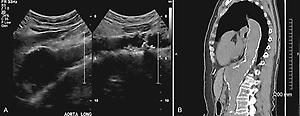
Arteries have three layers: intima, media, and adventitia. The intima, the inner layer, is composed of the endothelium and the internal elastic lamina, along with scant intervening tissue. The intima is the main layer involved in the formation of atherosclerotic plaques. The adventitia, the outer layer, consists of connective tissue and carries nerves and the vasa vasorum.
The media supplies much of the strength of the aorta and consists of elastin, collagen, smooth muscle cells, and extracellular matrix proteins. AAA formation is a disease largely involving the media and also the adventitia. The aorta is an elastic artery and the aortic media has high elastin content. With AAA, there is a significant decrease in elastin and collagen content in the media and adventitia. Destruction of elastin is mediated by enzymes such as matrix metalloproteinases (MMPs). Medications may be able to reduce the rate of elastin destruction, either by suppression of the MMPs or inhibiting other biochemical pathways. Statins and doxycycline are known inhibitors of MMP enzymes. Good evidence, however, is lacking regarding what may be the best medical therapy to help reduce the rate of AAA growth.
AAA is a disease of older persons. AAAs rarely occur before age 50 and affect men four times more often than women. The risk of developing an AAA also increases with smoking and with a family history of AAA in a first-degree relative. Other factors that increase risk are a history of peripheral vascular disease, cardiovascular disease, and hypertension. AAAs typically increase in diameter at a rate of 1.7 to 2.6 mm per year. This rate of growth increases as the AAA becomes larger. The rate of growth is faster in women.
As the size of the AAA increases, the risk of rupture increases. Rupture is rare when the AAA is less than 4.0 cm in diameter, with near 0% risk per year. The rate of rupture increases to 1% when the AAA is 4 to 4.9 cm, 1.0% to 11 % for AAAs 5.0 to 5.9 cm in diameter, 10% to 22% for AAAs 6.0 to 6.9 cm, and 30% to 33% for aneurysms larger than 7 cm. Although data for larger aneurysms are conflicting, when the diameter is greater than 6.0 cm, clearly the risk of rupture is significantly higher than for smaller aneurysms. Other risk factors for rupture include current smoking and chronic obstructive pulmonary disease. In addition, the rupture rate for women is four times that of men. Rupture in women occurs in smaller aneurysms, although the exact amount of increased risk is not well quantified. Because smaller AAAs in women have a risk similar to larger ones in men, elective treatment in women should occur at a smaller aneurysm size than in men. Recommendations about how much smaller vary from 3 mm to greater than 5 mm.
Current medical therapy is limited in its ability to prevent the growth of an AAA. Rate of aneurysm growth is increased in smokers and may be decreased in diabetics. Medications including statins and doxycycline have been suggested as possibly reducing the rate of aneurysm growth. To date, none of the current strategies for reducing rate of growth through medications has been shown to be very effective.
The malady of AAA meets the 10 World Health Organization criteria for the institution of screening programs. Research has been extensive, particularly in Europe, on the effectiveness and cost-effectiveness of ultrasound screening for AAA.
A meta-analysis commissioned by the US Preventive Services Task Force (USPSTF) combined analyses from four studies, including European studies. The analysts concluded that “for men age 65 to 75, an invitation to attend AAA screening reduces AAA-related mortality.” Based on these results, in 2005 the USPSTF published a recommendation for one-time screening for men aged 65 to 75 who had ever smoked. In 2014 the USPSTF issued an update reiterating this recommendation. The task force also recommended selective screening based on risk factors for men aged 65 to 75 who had never smoked. The risk factors they referenced were older age, positive smoking history, first-degree relative with AAA, history of other vascular aneurysm, coronary artery disease, cerebrovascular disease, atherosclerosis, hypercholesterolemia, obesity, and hypertension. The USPSTF believed the evidence to support screening for AAA in women smokers was inconclusive and consequently made no specific recommendation about such screening. The USPSTF recommended against routine screening for women who had never smoked.
The Screening Abdominal Aortic Aneurysms Very Efficiently (SAAAVE) Act was passed by the US Congress and signed on February 8, 2006. Since January 1, 2007, Medicare has covered a one-time, ultrasound screening to check for AAA in qualified patients. Qualified patients are men with a history of smoking (i.e., those who have smoked more than 100 cigarettes total during their lives) and men and women with a family history of AAA in a first-degree relative. To be covered, patients must undergo the AAA screening study as part of the Welcome to Medicare Physical Exam and complete the screening within the first 6 months of Medicare eligibility. Analysis of data from the first 2 years after the SAAVE Act was passed indicates that a minority (<20%) of the Medicare population that was eligible for AAA screening underwent screening. The impact of the SAAVE Act on the rate of AAA screening during those first 2 years was described as modest.
Across the world, a few countries currently have nationwide screening programs although several others have begun pilot studies. National screening has been implemented in Sweden, in all member nations of the United Kingdom (England, Scotland, Wales, and Northern Ireland), and in the United States. Sweden has achieved an impressive attendance rate of 85% of those eligible for its screening program.
Screening for AAA must have high sensitivity. It is mandatory that the entire infrarenal abdominal aorta be examined. The screening ultrasound has one of three results: positive, negative, or indeterminate. The number of expected indeterminate exams should be very low, much less than 5%.
There are currently two paradigms for ultrasound in the screening of AAAs. The first is embodied in the current guidelines issued by the American College of Radiology (ACR) and involves obtaining a full set of documentation images on every patient. When the screening examination is positive for AAA, the recommended images are adequate to document aneurysm size accurately. The screening examination thus also serves as the first diagnostic exam. This type of screening exam is not very different from a full “diagnostic” examination and is probably the most common type in radiology departments.
The second paradigm is used by several mobile companies offering aneurysm screening to the general population. These for-profit programs are prepaid by the individuals requesting screening; profit is based on doing a high volume of cases within a short time, keeping cost to a minimum. It is unclear whether adequate quality control mechanisms are in place for these exams, which often have only two possible results: positive and negative. Positive exams do not result in extension of the study to be diagnostic. Instead, a positive exam results in a recommendation to the patient to have a diagnostic evaluation. This allows the provider to save time and reduce cost.
The decreased cost of this type of examination offers a potential benefit. If the low cost of this type of service could be widely reproduced, and if the issue of quality control were addressed, screening that is both accurate and cost-effective could become available for a wider segment of the population.
Unfortunately, at least some of the programs make recommendations to their customers that cannot be supported by the literature such as the concept of needing to screen for AAA on a yearly basis. Screening on a yearly basis certainly will increase the number of patients using the service and increase profit but hardly seems to represent an disinterested attempt to improve health care. Atherosclerotic aneurysm formation is a very slow process and there is absolutely no need for yearly screening for someone without an aneurysm. There are some who would question whether a second screening is ever needed if the first screening was performed at age 65 or later. Certainly, once a first well-performed screen is negative there is no justification for rescreening except perhaps after many years.
Once an AAA is discovered, the patient moves from screening to a surveillance program in which the aneurysm size is periodically checked. Because an AAA tends to grow more rapidly as its size increases, there is general agreement that a smaller aneurysm needs to be checked less frequently than a larger one. Otherwise, however, consensus is lacking on frequency of sonographic surveillance. Recommendations for assessing aneurysms less than 4.0 cm in diameter range from 1 to 3 years. For the U.K. Small Aneurysm Trial, Brady et al. concluded that surveillance could be performed at intervals of 36, 24, 12, and 3 months for aneurysms of 35, 40, 45, and 50 mm, respectively. Following this schedule, the risk of the AAA size on recheck being greater than 55 mm would be less than 1%. Achieving a 5% rate would require even less frequent surveillance. Society for Vascular Surgery practice guidelines recommend surveillance at 36, 12, and 6 months for aneurysms between 3.0 and 3.4 cm, between 3.5 and 3.9 cm, and between 4.0 and 5.4 cm, respectively. They also recommend surveillance every 5 years for aortas between 2.6 and 2.9 cm in size. It has been suggested that aortic aneurysms may need even less frequent surveillance than what is cited above.
Up until several years ago, we scanned most aneurysms yearly. Our aneurysm clinic now follows AAAs sonographically every 2 years when the aneurysm is less than 40 mm, every year for aneurysms 40 to 44 mm, and every 6 months once the aneurysm reaches 45 mm.
Surveillance of aneurysms lends itself well to being followed by a database. Our interventional radiology–run aneurysm clinic started a database in 2003 to follow AAAs. Patients with known AAAs of any size are entered into the database. Patients are seen once in our interventional radiology clinic so that they can meet the physicians and advanced practice nurses involved and can be informed about their disease, its treatment, and how their aneurysm is to be followed. The clinic orders all subsequent aortic ultrasounds and monitors all results. After that first visit, all communication is by phone and by mail. The database is monitored periodically to make sure patients keep their appointments. When the aneurysm reaches 5.0 cm in greatest diameter, patients again begin to be seen regularly in the clinic.
Pertinent history should be obtained when doing surveillance on a known aneurysm. Questions of interest are whether the patient has back and/or abdominal pain or tenderness. These symptoms can be experienced by patients who have inflammatory aneurysms. In the absence of an inflammatory aneurysm, these symptoms are considered an indication for aneurysm repair.
The following principles apply both to screening examinations and studies for surveillance. Evaluation of the entire infrarenal aorta is necessary. Identifying the aortic bifurcation guarantees that one has seen far enough distally. By identifying the celiac, superior mesenteric, or renal arteries or the aortic hiatus of the diaphragm, sonographers can guarantee that the proximal examination has been carried high enough. Images should be obtained in both transverse and longitudinal planes. The goal is to find the maximum diameter of the aorta, measured from outer edge of the wall to outer edge of the opposite wall. Measurements should be taken perpendicular to the axis of the lumen of the aorta. To guarantee that the measurement is perpendicular, longitudinal images are usually best for obtaining the most accurate measurements ( Fig. 12.3 ). The measurement includes both the front and the back walls.

Most infrarenal aneurysms are fusiform in shape with a relatively circular cross section. With a fusiform aneurysm, measurement of its size taken from any longitudinal plane through the aorta will be the same ( Fig. 12.4 ). The walls of the aorta are generally well seen with longitudinal imaging because they are parallel to the face of the transducer, resulting in a strong echo from the walls. Transverse imaging is particularly important to identify the small proportion of aneurysms that are eccentric. If the aneurysm is eccentric, the measurement must be taken in the plane of the aneurysm's eccentricity to find the largest diameter of the aneurysm ( Figs. 12.5 and 12.6 ).
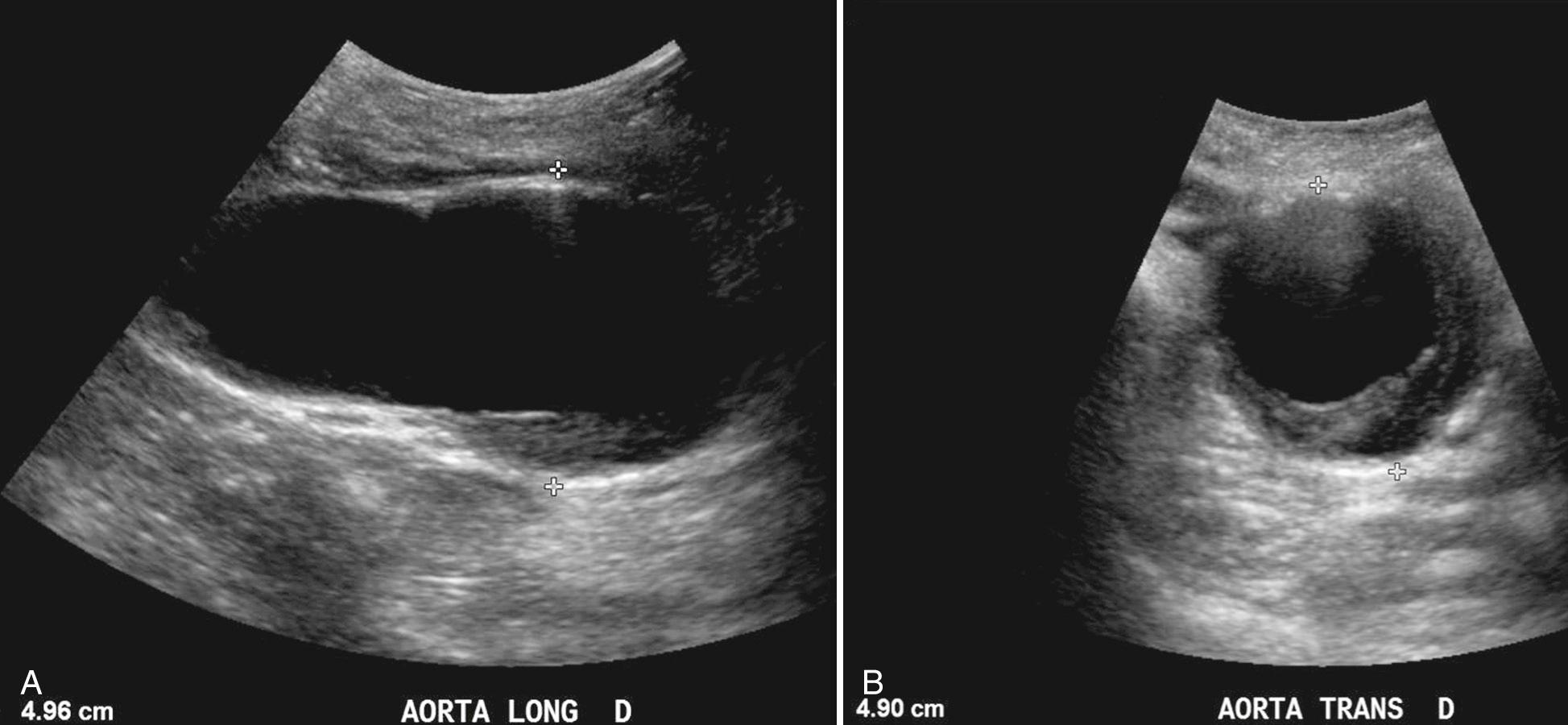
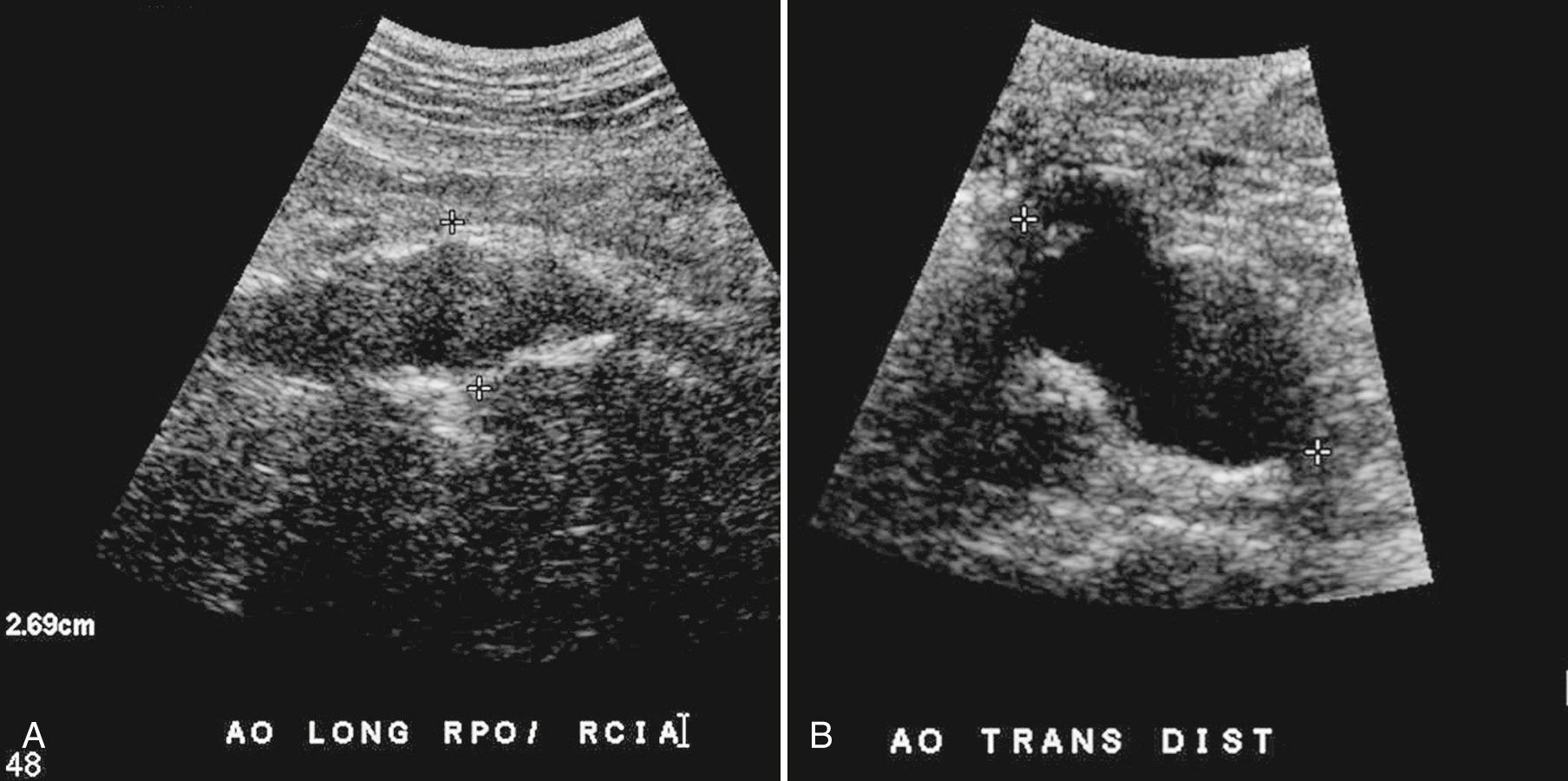

We routinely image patients from two windows: the anterior abdominal midline (sagittal plane), which allows imaging of the maximum length of the abdominal aorta, and the left flank (near the coronal plane), with the patient in the right lateral decubitus position. The middle and distal abdominal aorta are often better seen in this position, particularly in obese patients. The proximal common iliac arteries may also be better seen in this position.
We obtain longitudinal and transverse cine loops from an anterior window and from a left lateral window. The longitudinal cine loops allow for easy remeasurement of the aorta by the reviewing physician. The transverse cine loops allow the reviewing physician to determine whether there is eccentricity of the aneurysm.
Computed tomography (CT) has a limited role in AAA screening and surveillance but should be used in any of the following situations:
The patient is so obese or otherwise difficult to image that whether the aneurysm may be eccentric cannot be determined with reasonable certainty on initial scanning. Once the aneurysm is shown to be fusiform, performing most of the further surveillance with ultrasound is reasonable.
The aneurysm is known to be eccentric, and the area of eccentricity is not optimally seen with ultrasound.
The patient is acutely symptomatic (including emergency room patients).
Portions of the iliac arteries that are known to be aneurysmal are not well seen.
The AAA is suspected to be an inflammatory AAA (described later) and has not yet been imaged with CT.
The aneurysm is suspected of having reached a size at which treatment planning is needed.
Screening for aortic aneurysm should be highly accurate. Nonetheless, we have encountered two sets of circumstances where it is possible to have a false-positive study. The first can happen when the aorta at the diaphragmatic hiatus measures 3.0 cm or greater and is mistakenly called “aneurysmal.” The normal size of the supraceliac aorta is 2.1 to 2.7 cm. Based on a definition of aneurysm that requires the diameter to be 1.5 times or more the normal diameter, a small aorta would not become aneurysmal until it reached approximately 3.2 cm in diameter, whereas the larger supraceliac aorta would not be aneurysmal even at 4.0 cm.
The second circumstance where we have seen several false-positive studies is when the spine is mistaken for the posterior wall of the aorta. This is particularly likely to occur when visualization is poor, as in a very obese patient. The true posterior wall of the aorta may then be difficult to determine. Usually, transverse imaging or imaging from the left flank will help define the true posterior wall to help determine if an aneurysm is present ( Fig. 12.7 ).

False-negative studies may occur if visualization of the infrarenal aorta is incomplete. If the entire infrarenal aorta is well seen in longitudinal imaging, the diagnostician can exclude the presence of a fusiform aneurysm, the most common type of AAA. However, if the entire infrarenal aorta is not well seen in the transverse plane, an eccentric aneurysm is not excluded (see Figs. 12.5 and 12.6 ).
As previously mentioned, rupture of aortic aneurysms is catastrophic, usually resulting in the patient's death. Although it played a role in the rapid diagnosis of ruptured AAAs in the emergency room 30 years ago, ultrasound no longer has such a place at most institutions. The near ubiquitousness of high-speed multidetector CT scanners has made CT diagnosis extremely rapid. CT has a number of other advantages in comparison to ultrasound. CT, even without intravenous contrast, is diagnostic of AAA in all cases, is highly diagnostic of retroperitoneal bleeding associated with aneurysm rupture, and is not operator dependent.
Because of these factors, obtaining a formal ultrasound in patients with an emergent need for diagnosis in most settings is unwise. If the patient has a ruptured AAA, time is of the essence, and the patient needs the most complete information that can be obtained in a reliable way. Performing ultrasound risks wasting precious minutes that may be the difference between patient survival and death ( Fig. 12.8 ).

Treatment of large AAAs involves either open surgical repair or endovascular aortic repair (EVAR). Endovascular repair involved the placement of an endoluminal graft (also known as a stent graft ) to create a new channel for blood flow through the aneurysm isolating the aneurysmal sac.
Computed tomography angiography (CTA) is the most appropriate imaging method for AAA treatment planning. In the setting of open repair, CTA accurately assesses the degree to which the iliac arteries may be involved with the aneurysm. In addition, evaluation of the mesenteric arteries is of value to determine whether reimplantation of the inferior mesenteric artery (IMA) is needed. For EVAR, the distance of the renal arteries from the top of the aneurysm and the presence and location of accessory renal arteries are important. Knowledge of the three-dimensional anatomy of the aneurysm and size and configuration of the iliac arteries is critical.
After open surgical repair of an aortic aneurysm, imaging surveillance generally is not performed. Imaging is used to assess postoperative complications, including thrombosis, infection, stenosis (graft kink, neointimal hyperplasia, atherosclerosis), and anastomotic pseudoaneurysm. Ultrasound may play a role in the diagnosis of any of these complications. Another complication is aortoenteric fistula, generally to the third portion of the duodenum, which is potentially catastrophic and presents most often with upper gastrointestinal bleeding. Ultrasound has no role to play in the diagnosis of aortoenteric fistula.
Ultrasound has a larger, potentially much larger, role to play after repair of AAAs with EVAR. Current recommendations include lifelong imaging surveillance for endoleaks and graft migration in patients who have undergone EVAR for AAA. An endoleak is an area of the AAA that has been excluded by the stent graft that nonetheless continues to have blood flow. There are four types of endoleaks, categorized by four different sources of blood flowing into the aneurysmal sac ( Fig. 12.9 ). Egress of blood from the sac is usually through patent aortic branches in all types of endoleak.
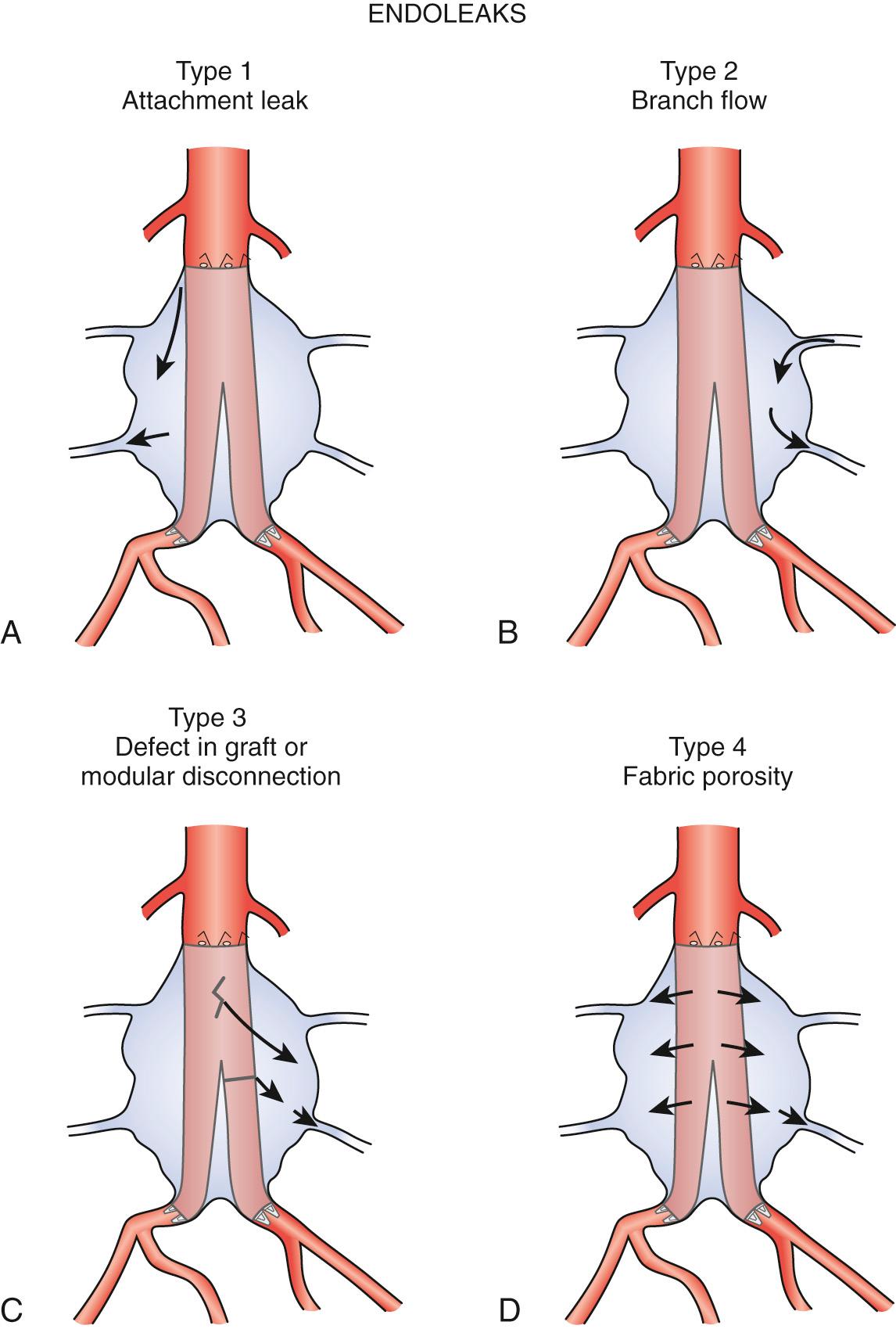
With a type 1 leak, one of the ends of the stent graft is not tightly apposed to the arterial wall, allowing blood to enter the aneurysmal sac ( Fig. 12.10 ). A type 2 leak is caused by retrograde flow into the aneurysm sac through an aortic branch, usually the IMA or a lumbar artery ( Fig. 12.11 , and 12.2 ). In a type 3 leak, there is disruption of the integrity of the stent graft, caused by a fabric tear or a separation of component parts of the modular stent graft ( Fig. 12.12 , and 12.4 ). A type 4 leak is caused by porosity of the stent graft fabric with blood actually going through the pores in the fabric. This is seen only early after placement and is self-correcting. The term endotension refers to an aneurysm sac that stays pressurized in the presence of a stent graft. This is sometimes referred to as a type 5 endoleak. Its presence is inferred by continued growth in the aneurysm sac size in the absence of detecting another type of leak.
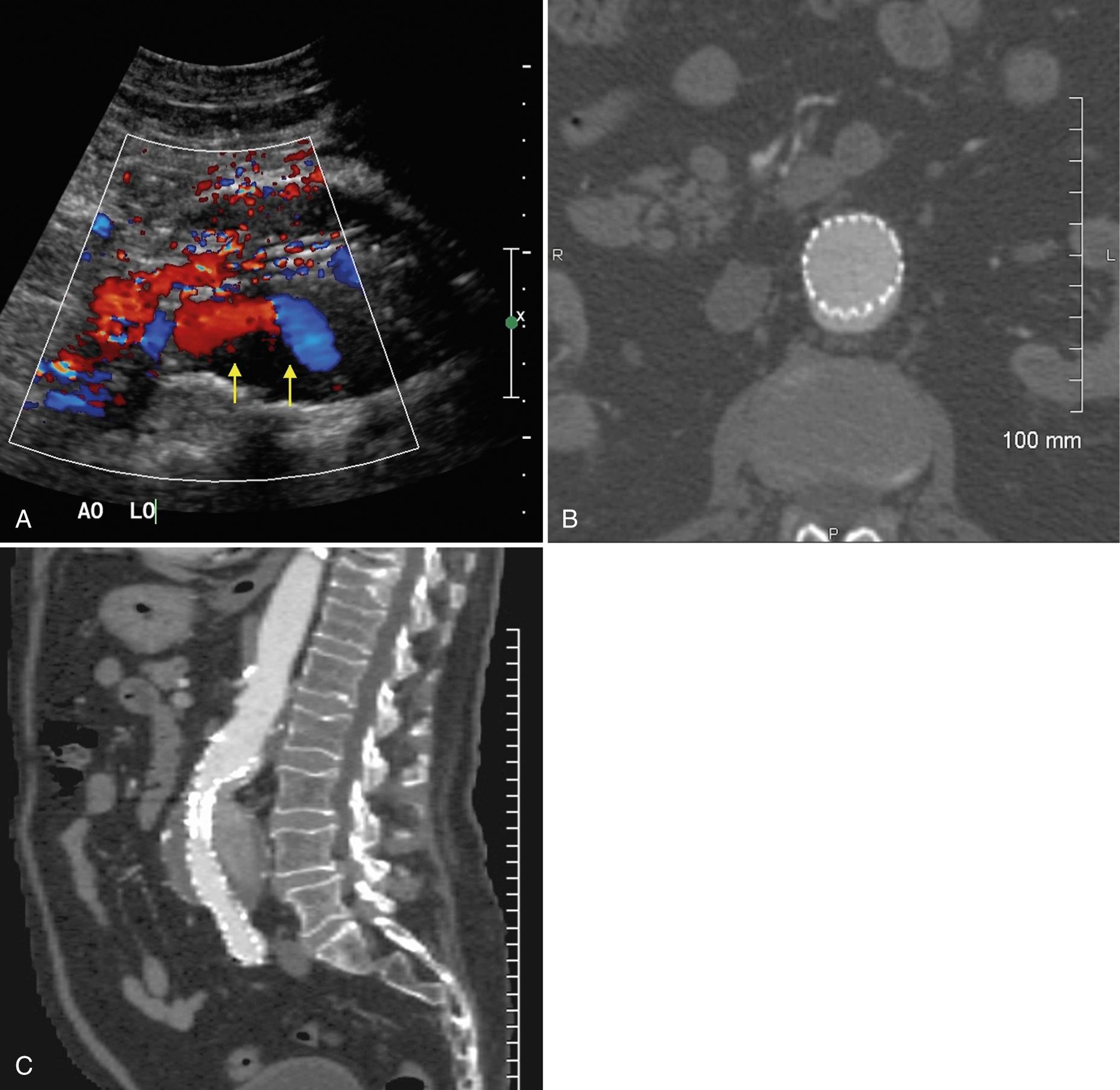
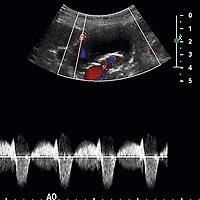
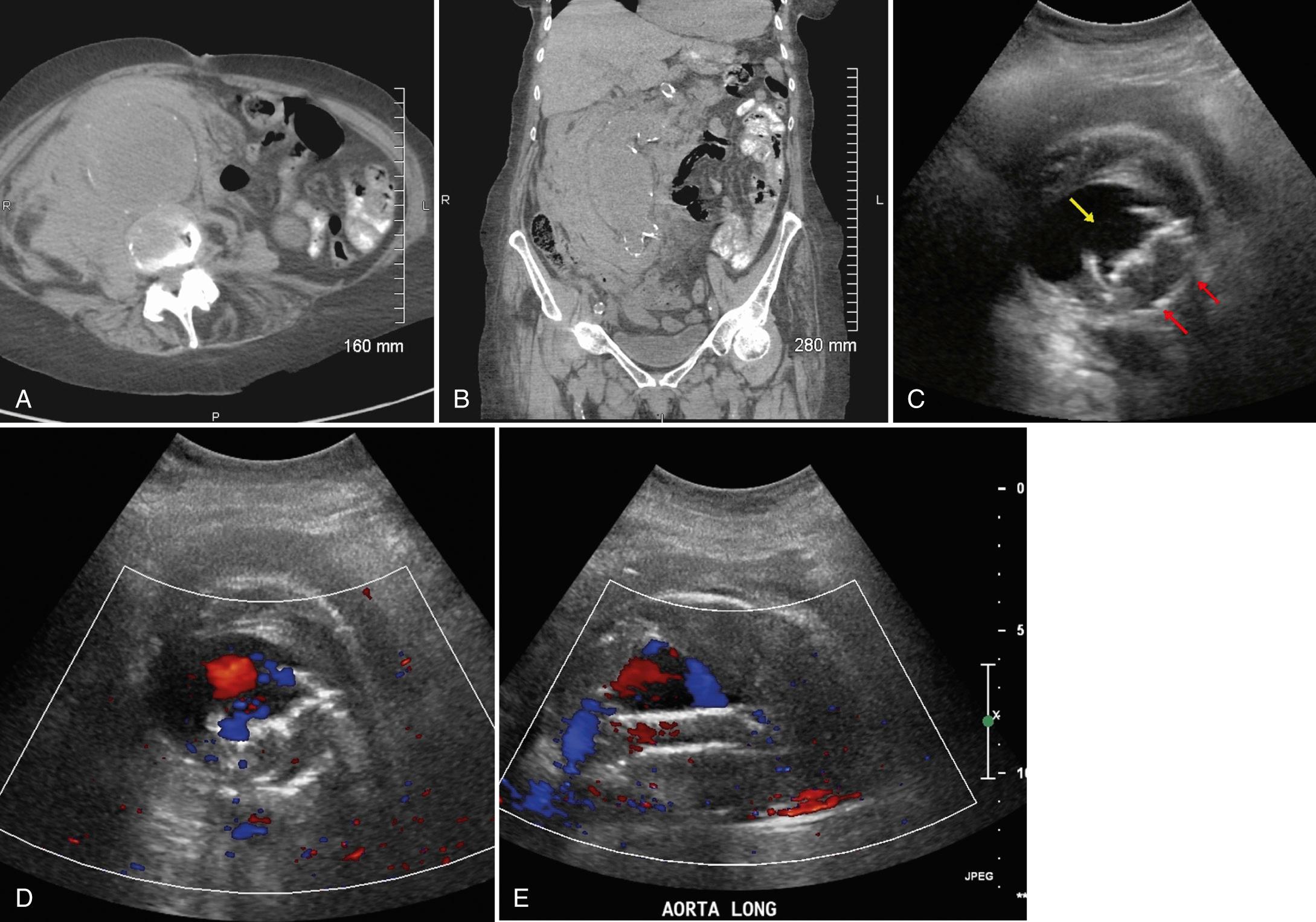
With an endoleak, a treated aneurysm may continue to grow and eventually rupture. Endoleaks occur in approximately one-third of AAAs treated with stent grafts. Types 1 and 3 endoleaks require immediate treatment when diagnosed. Type 4 endoleaks are generally seen only during placement of the stent graft and are self-limited, requiring no treatment. More judgment is involved in the care of type 2 leaks. Small leaks may be watched over time to see if they resolve and whether expansion of the aneurysm occurs.
Because of the possibility of endoleaks, AAAs treated with stent grafts undergo routine imaging surveillance. Imaging most often includes yearly, contrast-enhanced, multiphase CT examinations. This regular imaging greatly increases cost and exposes patients to contrast and substantial radiation. Color duplex Doppler sonography alone can be used to visualize endoleaks. Several studies suggest that standard color duplex Doppler ultrasound may be the preferred method of surveillance. Studies comparing contrast-enhanced duplex with standard color duplex have found the addition of contrast improves the quality of the study. Several studies suggest that contrast-enhanced ultrasound is at least as sensitive as CT for the detection of endoleaks. The issue is still a topic of research, although with more experience, contrast-enhanced ultrasound likely will play a significant role in AAA endoluminal graft surveillance.
As already mentioned, surveillance for graft migration is also necessary after EVAR. In those undergoing surveillance for endoleak with color duplex Doppler sonography, plain radiography can be used to assess for graft migration.
Become a Clinical Tree membership for Full access and enjoy Unlimited articles
If you are a member. Log in here